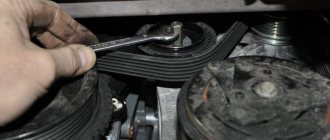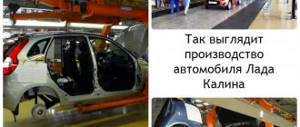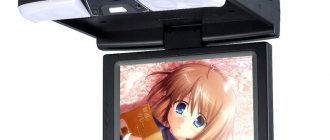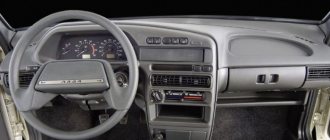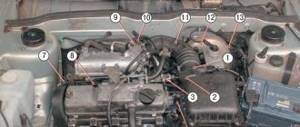Adjusting old-style E-gas
The block cover (11183-1108500) is fixed with bolts that are inserted into oval holes. The improvement is this. to loosen the 4 screws and turn the cover in the desired direction:
- Economy mode (counterclockwise). To drive smoothly, to accelerate, you should press the pedal a little more than before. Gasoline consumption is reduced;
- Active mode (clockwise). The car reacts even with slight pressure on the gas pedal. Gasoline consumption increases. The pedal becomes more sensitive and informative.
In other words, we get the same effect as after installing JETTER (Jetter or spur).
It has been noticed that the first minutes after such settings, the idle speed may be increased (about 1300 rpm). But after a minute, the ECU gradually adjusted and the speed dropped to the usual level. If this does not happen, turn on the ignition for a minute and then start the engine.
If necessary, you can easily return to the original position (mark it in advance).
Refinement of a new electronic gas pedal
The pedal assembly (11183-1108500-01) does not have oval holes, which does not allow adjustment in the manner described above. Instead, it is proposed to cut off the protrusion (by 2-3 mm), which prevents the pedal from moving completely. This modernization made it possible to increase the pedal travel, which made acceleration with “pedal to the floor” more active. It is also noted that there is no hesitation when pressing the pedal sharply.
What I don’t like about the pedal assembly (8450008980), which is installed on Lada Vesta:
- tight gas pedal;
- large free play of the gas pedal (about 8 mm at the tip of the pedal).
What to do if your gas pedal is stuck
A stuck gas pedal is an electrical or mechanical problem that can occur in any vehicle. If this happens to your car, the most important thing is to remain calm and not panic. The algorithm of actions is quite simple
- Switch the gearbox to neutral.
- Start slowing down.
- Turn on the emergency lights.
- Find the nearest safe place to stop.
- After stopping, turn off the ignition.
Let's look at the recommendations in more detail.
- Stay calm and don't panic. You have enough time to make a decision in this situation if you do not panic. Panic is dangerous not only for you but also for other drivers, so it is important to take a deep breath and remain calm.
- Be aware of the situation on the road around the car. Assess the road situation around the car and begin to calmly look for a safe place to stop.
- Try to lift the gas pedal with the toe of your right foot. The problem is often due to the pedal itself. If this is the case, then lifting the gas pedal with your toe will return the car to idle mode, which will allow you to stop safely. At the same time, keep your eyes on the road, and do not look at the floor and pedals.
- Do not try to lift the pedal with your left foot, as if you need to brake urgently, your left foot will get in the way.
- If the gas pedal rises freely, but the engine speed does not change, then the problem does not lie in the pedal
- Engage neutral gear. Engaging the neutral gear will stop the uncontrolled acceleration of the vehicle. If you have a car with a manual transmission, by depressing the clutch pedal you can stop the car from accelerating and, in principle, regulate the acceleration to a safe stop. If you are driving a car with an automatic transmission, you need to set the automatic transmission shift lever to the “N” position. It is absolutely safe for the car. The most important condition is not to make a mistake and not set the reverse speed “R” or parking “P” .
- Do not use the emergency or parking brake . The emergency or parking brake is not intended to stop a vehicle in motion. Applying the parking brake may cause your vehicle to lose control and skid on the road. The emergency brake should only be used to stop the vehicle in an emergency situation when the brakes fail completely. Using the emergency brake can also lead to loss of control of the vehicle.
After stopping the car, you need to turn on the hazard lights and call a tow truck. You cannot operate the car with a stuck gas pedal.
Feedback on the E-Gas modification
Car enthusiasts who have already completed the adjustment note that if you move the pedal assembly cover clockwise, the car becomes a little more lively. If you press the pedal as before and the car starts to move, you have to get used to it and not press the gas so hard. When you press the pedal to the floor, you can't feel the difference.
Those who adjusted the E-gas for a quieter ride noticed that driving on the highway became more comfortable. Now, to maintain speed, you need to press the gas pedal a little harder, which allows your leg to not be as tense as before.
Other motorists do not believe in the positive effect, saying that it is all self-hypnosis. The operation of the electronic gas pedal is based on changing the resistance difference. And even if you move the cover, when the engine starts, the ECU will still consider it to be zero and adjust the throttle from this point. And if you increase the sector stroke, the E-gas error “signal outside the permissible limits!” will appear.
Have you encountered such modification of E-gas? What feedback can you leave about such adjustments? Is there a positive effect or is it all at the level of self-hypnosis? Let us remind you that if necessary, you can check the E-gas yourself. By the way, an alternative to modifying the electronic gas pedal is chip tuning.
How does an electronic gas pedal work, how are its advantages and disadvantages manifested, what malfunctions are most common, and how to deal with them? All these questions are very relevant, because today many car manufacturers have replaced the traditional cable drive with a more modern electronic pedal.
How does e-gas work?
E-gas consists of 3 elements: Electronic damper, sensor on the pedal, and the pedal itself.
The sensor on the pedal takes into account the degree to which the driver presses the gas and transmits the data to the ECU. The computer, in turn, sends a signal to the electric damper, which opens the way for air to enter the engine. Also in cars with an electronic pedal, frequency-type air flow sensors are used.
Each sensor is powered separately to the computer. In case of the slightest voltage deviation from the norm, errors appear: (P2122-P2123, P2127-P2128, P2138).
Electronic gas pedal - how does it work?
Modern technologies are aimed at making our lives as easy as possible. On the one hand, this is a huge plus, but on the other hand, they simply deprive us of the opportunity to make any decision, or rather, they correct it, and in such a way that it is not always possible to achieve the desired result. This is clearly visible in the operation of the electronic pedal, which is so popular in the modern automotive industry. Although for those who feel insecure behind the wheel, and especially do not delve into the technical nuances of the car, this innovation is only a plus.
The principle of operation of the electronic gas pedal is as follows: after the driver presses the accelerator, data on pressure angles immediately enters the control unit through special sensors. Next, the ECU comes into play, which calculates the required opening angle of the throttle valve, and the drive, based on the data received, opens it to this angle. Moreover, if it suddenly becomes necessary to change the value of this angle (for a more economical mode or safety), the control unit does it itself, without receiving the corresponding command. It turns out that the driver cannot 100% regulate this process.
Troubleshooting tips
If the cause of the gas pedal sticking is a bent mat, it should be replaced. But if the problem is in the cable, then you can do the following steps:
- You need to make sure that the cable is intact, visually check for damage; if there is none, then it is enough to apply lubricant.
- If there is damage, the cable must be replaced following the following instructions:
- you need to remove the tip from the throttle - remove it from the place of fixation using a flat screwdriver;
- disconnect the cable from the metal holder by squeezing the four clips;
- carefully disconnect all the fasteners that are located in the engine compartment;
- remove the casing from the rubber seal between the passenger compartment and the body using a screwdriver;
- it is necessary to disconnect the tip of the cable from the pedal, so on one side the cable needs to be aligned, add a little force on the other so that it comes out of the fixation point.
Important . You need to use the screwdriver very carefully so as not to damage the plastic petals. After replacing the cable, it is advisable to treat the points of possible friction and connections with the gas pedal with lubricant. The gas pedal regulates the amount of combustible mixture that enters the cylinders of the car's internal combustion engine. It is designed to control the engine speed and affects the speed of the vehicle. Therefore, it is very important that the gas pedal is in working order and does not dare to stick.
Sources:
https://autoflit.ru/466-ustanovka-elektronnaya-pedal-gaza-na-vaz-2114-ee-plyusy-i-minusy.html https://autotime.net.ua/chto-delat-esli-zapala -pedal-gaza/ https://club2108.ru/forum/viewtopic.php?id=998 https://litezona.ru/zapadaet-pedal-gaza-vaz-2114/ https://dixnews.ru/pochemu- mozhet-zastrjat-pedal-gaza-vo-vremja-ezdy-i-chto-s-jetim-delat/
When is it necessary to replace the electronic gas pedal?
Due to the fact that this is an electronic drive, the main faults in it are related to the electronics. There are two sensors built into the pedal bracket that transmit commands to the control unit. If one of these sensors fails, a light on the panel will light up, which is responsible for the serviceability of the engine control system. In this case, the ECU goes into standby mode (the speed increases much more slowly). If two sensors fail, the emergency mode will turn on and the engine will operate as if idling. Since the sensors cannot be repaired, the electronic gas pedal must be replaced.
The wiring may also be damaged, and then the operation of the throttle will be disrupted. If the electric motor is worn out, then the monitor also displays an error indicating an accident. These damages can be eliminated, but if the accelerator of the electronic gas pedal, which is responsible for the dynamics of the car, fails, then this part should be immediately replaced with a new one. We'll look at how to do this below.
Electronic gas pedal repair – we fix the breakdowns ourselves
Basically, if any problems occur, the entire assembly must be replaced. But before taking such drastic actions, it would not hurt to find out the cause of the breakdown. To do this, of course, it is worth reading the information on how to check the electronic gas pedal. To do this, you need to disconnect the block and sensors, and then unscrew the fastening nuts and remove the pedal.
To directly check, you will need a multimeter: by connecting it to different terminals, we monitor the change in electrical resistance. It should decrease smoothly, but if jumps are observed, then the part is faulty.
In some cases, it is also possible to repair the electronic gas pedal, for example, if the wiring is damaged. So, having discovered a defect (the insulation is broken, the wires themselves are damaged, etc.), you need to act according to the following scheme. Having freed the gear mounting axis, remove the harness. To do this, you need to unsolder the wires, release the bracket and pull out the cable. Then we replace the wires, and, having disassembled the connector under the pedal, solder them. Now you can assemble the damper and drive safely.


